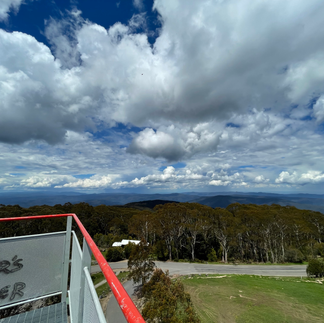Tatura
- sellrichard
- Nov 8, 2022
- 3 min read
About two hours north of Melbourne, where sheep and cow pastures stretch for miles on end you're greeted by some cow-shaped signs telling you to "turn the udder cheek and moove on."
However, during WWII, the area used to be site of a massive internment complex. There were up to five camps around Tatura, some for POWs and some of interned single males or families (mostly German, Japanese, or Italian). Initially, a large number of internees were sent to Australia from Britain or Palestine, such as the people classified as "enemy aliens" who were shipped on the HMT Dunera under atrocious conditions. Those families would eventually raise their kids, establish a school and keep each other entertained by putting on theater or musical performances.

One of the camps, the Dhurringile mansion (yes, I was finally told how to pronounce this correctly), was where German officers were interred, including my grandfather staring in January 1942.


Because the mansion is still part of a prison today, I couldn't get a close look, and had to snap a quick picture on my drive to Tatura.

At the Tatura War Time Camps and Irrigation Museum, I was greeted by George Ferguson, who is one of the lovely volunteers who keep the museum and its archives running. Unfortunately, George couldn't take me on a tour of Camp 1 because of the recent flooding and the current landowner being in hospital. He did, however, take his time to walk me through the museum and look up my grandfather's file.

If I was hoping for some earth-shattering discoveries, I was thoroughly disappointed, because there was nothing under Greter in the files except the basic information like birthdate, internment dates, and religious affiliation. (Not sure what Evangelist means but that's what they had put down for him.) Interestingly, they had the date of his death in the files as well, so someone must have updated them after my grandfather's death in 2004.
In contrast to my grandfather, other internees left more of mark. The highlights of the museum were some of the artifacts that POWs created during their time in camp. For example, the water colors by one of the sailors on the Kormoran, Georg Rosenkranz. Particularly the image on the bottom caught my eye because it shows the scene "loading a torpedo on Kormoran." (You may remember that my grandfather was the torpedo officer, so I assume that he was the one ordering the loading of torpedos to sailors like Rosenkranz).

There was also the hand-drawn map of Southeast Australia that Captain Detmers had on him during his attempted escape in January 1945. Yes, they dug an elaborate tunnel and 20 prisoners escaped. Not sure what their plan was in terms of leaving an island continent, but I guess they thought it was worth the try. In his memoirs, my grandfather talks about a tunnel being dug, but it sounds rather nonchalant. -- We dug a tunnel. 20 of us escaped during the night. They came back a few days later.

At the end of my visit, George put on a video for me that explained in detail the history of the camps and what life was like for the internees. I thought I spotted my grandfather in a picture of a bunch of men in costumes from a theater performance. But maybe I was too eager to find some kind of trace he left in this place. In any case, I quickly grabbed my phone to snap a picture.

I left the museum with two main impressions. (1) Gratitude for the volunteer folks who keep this museum running and the memory of the internee experience at Tatura alive. (2) The realization that things don't always go as planned and that's ok. Der Weg ist das Ziel as you say in German.
When my grandfather left this place in early 1947, he was excited to be back home and escape, among other things, the monotony of the central Victorian landscape.

I wonder if he ever knew how varied the landscape of the state actually was. Being confined to the camp for 5 years, he never had the chance to appreciate the beauty of the country. I drove back towards Melbourne through the Yarra Ranges National Park and it felt like being in a rainforest. (I think it is actually classified as a rainforest in parts). Here are some picture for you nature nerds out there:
For you military history buffs, I also have one more set of images you might appreciate: Tatura is also the site of the only official German military cemetery in Australia.
P.S.:
I am now in Perth and will visit the Maritime History Museum and the Shipwrecks Museum in Fremantle in the coming days. I was also told to go to Rottnest Island and take a selfie with a Quokka. Trying to decide what's more important.





















You know what Charlotte thinks is more important...